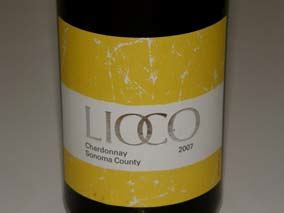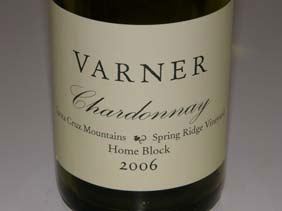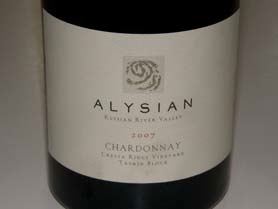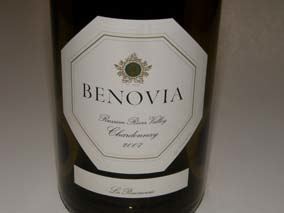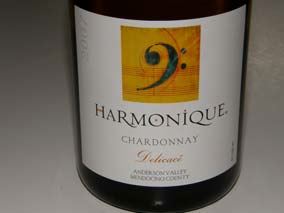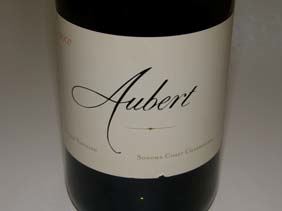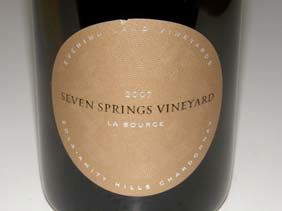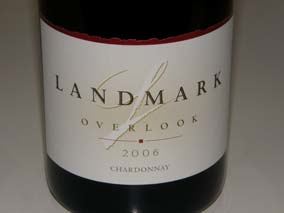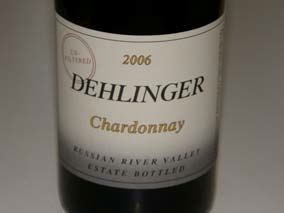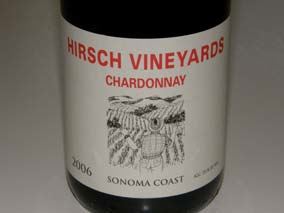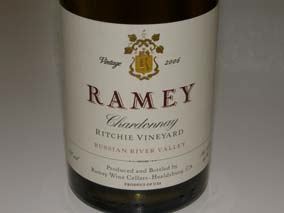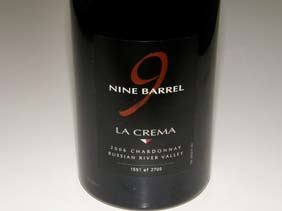California Chardonnay Tasting
No, the title is not a misprint. The PinotFile has now been published over eight years, and I have never done a
feature on Chardonnay. Sure, I have reviewed an occasional Chardonnay from Oregon and California, but my
focus and first love is Pinot Noir. My second love, and I finally have come out of the closet, is Chardonnay.
Yes, I have dabbled in the world of ABC (“Anything But Chardonnay”), and I have enjoyed many bottles of
Riesling, Sauvignon Blanc, Melon, and Pinot Gris. I keep returning to Chardonnay, especially the full-blown,
barrel fermented, in-your-face, lush style of Chardonnay that is often criticized as too fashionable and food-unfriendly.
Studies have shown that lovers of big, oaky Chardonnay are mostly male and over 60, so I fit right
in. I lost my Chardonnay innocence 20 years ago to Kistler, whose wines have provided me many pleasures
over this stretch, but I have recently found many other producers and styles to delight in. I am not such a
Chardonnay H-bomb devotee that I don’t appreciate other styles of domestic Chardonnay.
The Chardonnay camp seems to be split now into three groups. There are the advocates for nonoaked
Chardonnay which is crisp, fresh and lean, 100% barrel-fermented Chardonnay, and “tweener” Chardonnay
that combines barrel and stainless steel fermentation lots in the final blend. There are variations among these
groups as well with some employing 100% malolactic fermentation and others using this technique only
partially. Some winemakers such as Kevin Kelley of LIOCO have begun to ferment grapes on their skins,
hoping to add another dimension to Chardonnay. The oaked Chardonnays feature a flavor profile of caramel,
pineapple, vanilla, toast, butter and richness. The newer nonoaked Chardonnays emphasize focused and pure
flavors of minerals and green apple. Think lean as opposed to fat.
Chardonnay was not always the most popular wine in the United States. The Wente family in Livermore,
California bottled the first Chardonnay in 1933 and labeled it Pinot Chardonnay, a term originated by and
retained by the French for many years. The Chardonnays to follow from California, including those from
Hanzell and Stony Hill, were often lean, age-worthy and Chablis-styled. Sales of Chardonnay were miserable
According to DNA fingerprinting, Chardonnay is the offspring of Pinot Noir and Gouais Blanc. Few
mismatches have produced such a glorious offspring. Gouais Blanc and Pinot Noir were both
planted in northeastern France in the Middle Ages and this is where they had a fling. Pinot Noir
has become the grape of royalty, and Gouais Blanc has been banned in Burgundy and faded into
oblivion.
Chardonnay is often confused with Pinot Blanc, which looks similar and tastes somewhat alike.
Pinot Blanc, however, is a white mutation of Pinot Noir, like Pinot Gris, with each sharing the same
DNA. A third grape, Auxerrois Blanc, also confuses the picture, since some French nurseries sold
vines labeled as Chardonnay that were Auxerrois. Auxerrois is an offspring of Pinot Noir.
and planted acreage before 1970 was miniscule. It really took the now famous 1976 Paris wine tasting, at
which Chateau Montelena Chardonnay won the top award for white wine, to fuel Chardonnay popularity. By
the turn of this century, Chardonnay was ubiquitous in California. In 2006, according to Western Farm Press,
Chardonnay was the largest acreage wine grape with almost 95,000 acres. 53% of all white vine vineyards in
California by 2004 grew Chardonnay. The Nielsen Company, tracking the total U.S. food, drug, and major
market liquor channel, reported in August 2009, that Chardonnay was the top selling varietal by far with a
22.1% market share in sales and 20.9% share in volume. Year-on-year, Chardonnay sales have increased
3.9% while case volume increased 4.9%.
Regardless of what style of Chardonnay you prefer, one thing is certain. It is a whole lot easier to find good,
even great, domestic Chardonnay, than Pinot Noir. Over the past six months, I sampled 50 domestic
Chardonnays and the quality was remarkably high. Many of these wines are small production, expensive and
strictly allocated through mailing list offerings. I have chosen to review below the 23 best examples I tasted. All but one are from California.
Keep in mind my admission above regarding my stylistic preference.

2007 Lucas & Lewellen Santa Barbara County Chardonnay
13.7% alc., pH 3.33, 1,002 cases,
$16. Sourced from younger vines of Los Alamos and Goodchild vineyards in northern Santa Barbara
County. Stainless steel fermented. Winemaker was Megan McGrath.
·
Pale yellow color. Complex
nose showing aromas of white peaches, pears, melon, lemons and spring flowers. The flavors echo
the nose with a subtle edge of herbs and resin. Soft and clean with bright acidity. Perfect with turkey.

2007 LIOCO Sonoma County Chardonnay
14.5% alc., $19, screw cap.
Fermented in stainless steel with wild yeast, 100% MLF. Aged in tank sur
lees for 5 months. Unfined and unfiltered.
·
Scents of apple, lemon,
honey, yeast and popcorn. Luscious and full-flavored with fruit that
seems to jump out in the mouth. The essence of Chardonnay with flavors
of pears, honey, nutmeg and nuts. Smooth and perfectly balanced. Best
value in California Chardonnay on the market.

2007 LIOCO Demuth Vineyard Anderson Valley Chardonnay
13.8% alc., 225 cases, $35. The Demuth
Vineyard is situated at 1,600 feet above the floor of the Anderson Valley. Wente clone is own-rooted in 1982.
Whole cluster pressed, cold fermentation in stainless steel with wild yeast, natural MLF. 6 months lees contact.
Unfined and unfiltered. No oak.
·
Terrific aromatics flashing ripe pears, green apples, warm cookies and
graham. The flavors are reminiscent of a warm apple tart, with hints of apricot and toast. Smooth and creamy
with a lively citric acid lift on the back end. Fresh and very bright.
2007 Alysian Cresta Ridge Vineyard Taurin Block Russian River Valley Chardonnay
14.3% alc., $38. Pronounced “ah-liss-ee-uhn,” referring to an
endeavor arising from intuitive creativity and artistic resolution. The inaugural
Chardonnay from Gary Farrell’s new label.
·
A very pretty wine with aromas of
honey and warm biscuits. Juicy flavors of lemon curd, pear and banana with a
sidecar of smoky oak. Perfect fruit and acid balance with a seductively creamy
texture. This one has the whole package.
2007 Pfendler Vineyards Sonoma Coast Chardonnay
14.2% alc., 150 cases, $38. Clone 4. Aged 11
months in 50% new French oak barrels.
·
A “tweener” Chardonnay with a moderately rich mid-palate and oak
spice influence, but crisp and clean. Flavors of green apples, pear and citrus are supported by a spark of
acidity.
2007 Harmonique Un-Oaked Anderson Valley Chardonnay
13.4% alc., 165 cases, $39. Grapes are from
the 24-year-old vines at Conzelman Vineyard. Clone is believed to be Wente. Yields less than 1.5 tons per
acre. Fermented in a combination of stainless steel and neutral oak for 8 months, then bottled and aged for 3
months before release. Inaugural vintage of this wine. Winemaker was Robert Klindt.
·
Citrus, butter and
of tropical fruits on the nose. Great purity of citrus fruits with a hint of pear. Brisk acidity and a refreshing finish.
2007 Benovia La Pommeraie Vineyard Russian River Valley Pinot Noir
14.5%
alc., $48. This vineyard is owned and farmed by George Martinelli and was once
an apple orchard. Planted to high density Dijon 95 and Old Wente clones.
·
The
name, La Pommeraie, French for apple orchard, fits this wine perfectly. Redolent
of fresh green apples on the nose and palate with a perfect touch of toasted oak
and citrus. A dancing Chardonnay that is crisp and fresh, yet rich enough for
hedonists.
2007 Paul Lato “Le Souvenir” Sierra Madre Vineyard Santa Maria Valley Chardonnay
14.1% alc., 75
cases, $48. Full MLF, aged in 66% new French oak, unfiltered.
·
Pear and vanillin scents are augmented with
notes of yeast and smoke. A rich but not cumbersome wine with full-on flavors of pears, lemons and the
faintest oak. Smoke shows up on the finish. The overall impression is a juicy wine that is vivid and bright.
2007 Harmonique Delicacé Anderson Valley Chardonnay
13.9% alc., 98
cases, $59. Grapes sourced from the 24-year-old vines at Conzelman Vineyard.
Clone is believed to be Wente. Yields less than 1.5 tons per acre. Whole cluster
pressed, fermented in a combination of new French oak, neutral oak and
stainless steel barrels. After blending of separate lots, the wine was aged for 8
months, and then bottle aged for an additional 4 months before release.
·
Straw
colored. Aromas of citrus, banana and oak toast. Subdued but pleasing white
stone fruit flavors with a sidecar of caramel from oak. More richness and
fullness on the palate than the un-oaked version but not overblown. I mixed this
Chardonnay with the Harmonique un-oaked version and felt this produced an
even more complete Chardonnay.
2007 Aubert Ritchie Vineyard Sonoma Coast Chardonnay
15.1% alc., $80.
·
Deep golden yellow color. Nose of pears, apples, butterscotch and the faintest
toasted oak. Rich and generously flavored, featuring pears, white peaches and
toasty oak. A big, in your face wine with a hint of heat on the finish. The texture is
pure cream and the lively grip of acidity plays off the fruit nicely. A full-throttle
Chardonnay that is very alluring. I must admit a weakness for this type of
Chardonnay.
2007 Aubert Lauren Sonoma Coast Chardonnay
15.8% alc., $90.
·
A sipping Chardonnay featuring a rich
and full-bodied palate of butterscotch, butter, light caramel, smoke and toasty oak. Full-bodied and creamy
with a big, lengthy finish that is slightly hot. Fun to contemplate but two glasses max!
2006 Landmark Overlook Chardonnay
14.4% alc., $21. 77% Sonoma County,
14% Santa Barbara County, and 9% Monterey County.
·
Yellow gold color.
Pleasing aromas of pears, apples, butter, and toasty oak. Moderately rich core of
yellow fruits including pears, apples and banana with a snappy and cleansing
finish. One of the most consistently reliable producers of Chardonnay in California.
2006 Dehlinger Russian River Valley Chardonnay
14.5% alc., $33.
·
Pale yellow
with the slightest haze (unfiltered). Demure perfume of honeysuckle, lemon zest
and riverbed. Discreetly rich flavors of white peaches, roasted nuts, and oak spice
with a mineral underpinning. An elegantly and restrained wine that is charming
and stylish. Dehlinger has quietly crafted one of California’s best Chardonnays for
many years.
2006 Windy Oaks Estate One Acre Estate Santa Cruz Mountains Chardonnay
13.9% alc., $38. Barrel
fermented, aged a minimum of 15 months. Unfined and unfiltered.
·
Golden yellow, slightly hazy color. Alluring
aromas of butter, grapefruit and beeswax. Penetrating flavors of white stone fruits with an echo of oak. The
viscous mouth feel is very appealing and the aromatic finish is fruity and lengthy.
2006 Hirsch Vineyard Sonoma Coast Chardonnay
15.1% alc., $50. The first
Chardonnay release from Hirsch fruit that formerly was vinified by winery clients.
·
Intriguing aromas of green apples, wet stones and smoke. Tangy apple flavors
with oak playing a supporting role. Hi-tone acidity and remarkable minerality.
Really good.
2006 L’Angevin Charles Heintz Vineyard Sonoma Coast Chardonnay
14.2% alc., $55. I have sampled this
wine on several occasions with consistent results. I am addicted to this wine.
·
Alive with the scent and flavor of
baking spice including cinnamon. A lush middle palate features multilayered tastes of apple tart, poached
pears, and fresh lemon curd. The fruit is pulled into line with fine acidity and the mouth feel is soft and creamy.
Perfectly composed and special in every way.
2006 Ramey Ritchie Vineyard Russian River Valley Chardonnay
14.5% alc.,
$63.
·
Demure apple and aromas which emerge with swirling. Very, very tasty apple
tart flavor with the faintest note of savory spices and oak. Finishes with a tangy
acidic edge. Sampled side-by-side with Aubert Ritchie Vineyard. Not as showy
and in your face as the Aubert bottling, but very charming. A debutante compared
to a hooker.
2006 La Crema Nine Barrel Russian River Valley Chardonnay
14,5% alc., 225
cases, $70. Nine best barrels in the cellar.
·
Very fruity nose with an array of
interesting aromas including roasted pear, tutti-fruity, vanilla and toasted meringue.
Full-bodied poached pear and apple tart flavors cascade through the palate. A
hedonistic wine for contemplation.
2005 Sonoma Coast Vineyards Sonoma Coast Chardonnay
14.2% alc., 395 cases, $45. Sourced from
Petersen and Hawk Hill Vineyards. Dijon 95 and Wente clones. Ages sur lees for 11 months using 50% new
Sirugue French oak.
·
Very Burgundian in style featuring flavors of apple, citrus, brioche and roasted nuts with
enough bright and crisp acidity to cut through lobster and an underlying minerality that is startling for California.
Simply great.
2005 Kistler Durell Vineyard Sonoma Coast Chardonnay
14.1% alc., 1,930 cases, $70.
·
Deep yellow with a
hint of orange. Aromas of poached apple, herbal oak and oak char. Tasty cooked white fruits with butter and
oak highlights. Charred oak runs throughout in the background. I prefer Kistler Chardonnays when they are
young.
|
|
|



